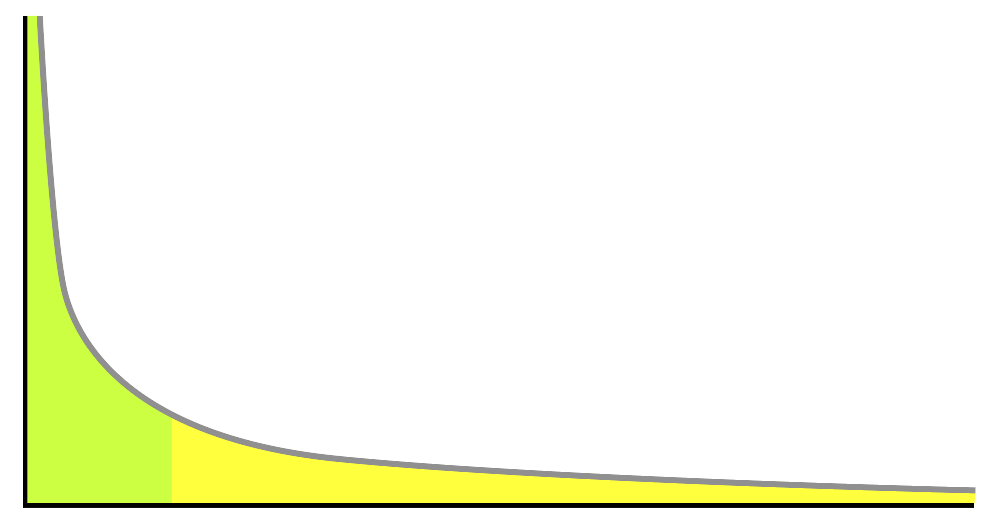
There’s an interesting phenomenon in statistics, that, as those things are known to do, also applies to blogging, business, learning, sales, software development and lots of other things besides. Since we are a blog by a software development company that sells e-learning software for businesses it only seems fitting that we would devote a word or two to that phenomenon.
You may know this phenomenon by one of its many names ― names that refer to its different aspects and characteristics: power law, long tail, 80/20 rule, the Pareto principle, etc.
Technically speaking, a “power law” is the mathematical relationship between two quantities in which one varies as a power of the other. One intuitive way to imagine how this plays out is to think of city sizes: there are few mega-cities (Tokyo, Mexico City, New York, London, etc), quite more moderate sized cities, numerous smaller cities and thousands upon thousands of villages. Or think of Twitter followers: there are a few people with tens of millions of followers, far more with millions or hundreds of thousands of followers, and a huge mass with a few hundred followers or less. Both distributions look like this:
The reason this phenomenon is interesting enough to warrant a blog post in an e-learning blog is that it nicely models lots of real life situations. Wikipedia mentions a few of them: “sizes of earthquakes, craters on the moon and of solar flares, the foraging pattern of various species, the frequencies of words in most languages, frequencies of family names, the sizes of power outages, wars, criminal charges per convict, and many other quantities” but there are tons of other phenomena it describes. What’s amazing is that the power-law distribution is equally applicable to both physical and man-made phenomena, and what’s even more amazing is how it relates to your business (or any business for that matter).
First of all, this very innocent looking mathematical notion describes the very size of the e-learning market. There are a few large e-learning schools at the top, several more smaller in size but still big in the middle, and numerous small schools in the bottom tier. It pays to know where one’s business fits in this, as it reveals who your true competitors are and what you should do moving forward.
There’s a corollary of the power law distribution called the Pareto principle (named after the Italian economist Vilfredo Pareto who came up with the relevant scientific theory). You may have seen its popular version on the internet as “you get 80% of the results for 20% of the work” but in really applies to all kinds of everyday distributions (it was originally intended as an observation about income inequality ― that 20% of the population holds 80% of the wealth).
The Pareto principle, or 80/20 rule as is also known, is something that comes up a lot in software development and engineering, and it also applies to building an e-learning course: 20% of the work will get you 80% of the way there, the rest is sweating the details and adding polish. Or, to put it in quantifiable terms, 20% of the features will cover 80% of your use cases (e.g. think of how you never use the huge majority of Microsoft Word’s features). The 80/20 rule is a useful guideline against extreme perfectionism and feature creep, and can help ground your deployment in reality.
A basic understanding of the Pareto principle and power laws can help you find (and fix) business inefficiencies and devote your energy where it matters. For example say that you plot your marketing budget per medium as compared to students that learned about your business from a particular medium. If the characteristic power law curve emerges as a result, then you know that 20% of your ads bring in 80% of your students ― and you can deduce from that which media outlets you should concentrate on.
Another interesting corollary of power law distributions is the so called “long tail”. This is the long end of the distribution where the numerous items that have smaller frequencies reside. An example from the e-learning market might make this concept clearer. As you know the majority of the students takes just a few popular courses (e.g. business administration, programming, etc), but there are still tons more courses that cater to increasingly smaller audiences (e.g. Pure Mathematics or Saz playing). Those myriads of courses that target niche audiences are the “long tail”.
Intuitively, an e-learning provider might be inclined to go for the “short tail”, so that he offers the most popular courses. And sure enough, this goes well with the 80/20 rule (you don’t have to offer every course, the right 20% of the courses will attract an 80% of the students). But there can be a business opportunity in the long tail too: if your margins are low (and e-learning helps with that, since you don’t even need to rent classes and pay teachers) you can do well by selling specialized lessons to the long tail of students that need them. This way you have less competition (as the majority of e-learning providers focus on the most popular courses) ― at least that’s the basic premise of The Chris Anderson’s celebrated 2004 book “Long Tail: Why the Future of Business Is Selling Less of More”.
We’ve barely scratched the surface of power law distributions and the 80/20 rule here, but I’d argue that we gave the 20% of the explanation that covers 80% of what you need to know. Read up on the rest (including bibliography suggestions) on Wikipedia. Stay tuned for more e-learning posts next week.



